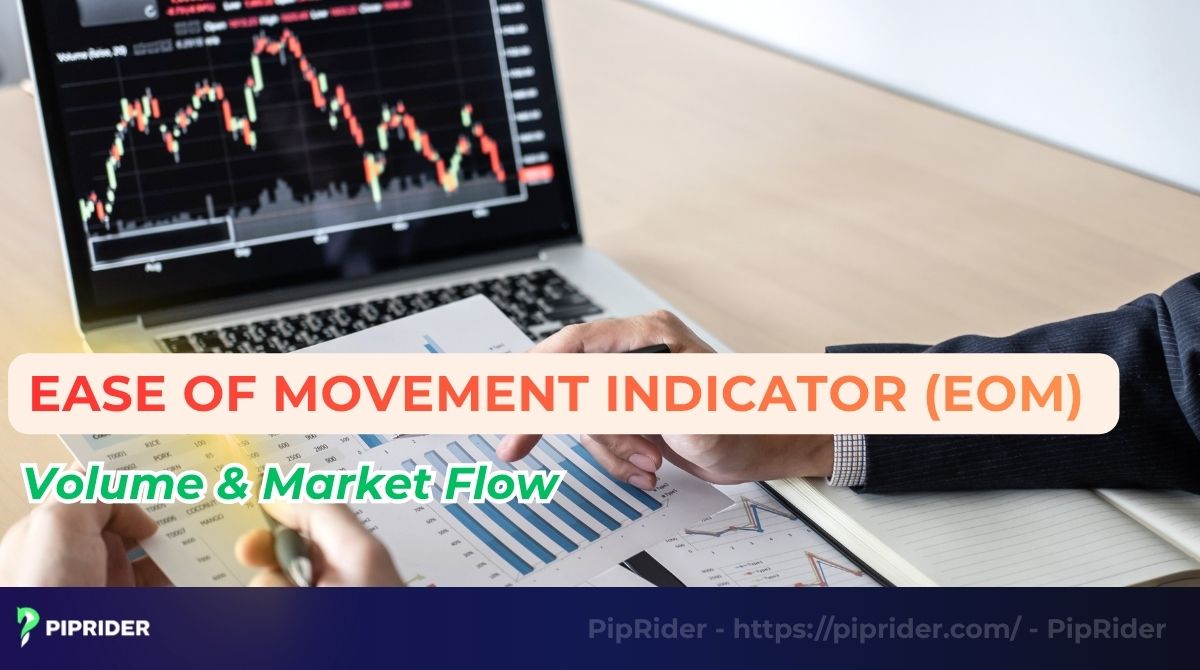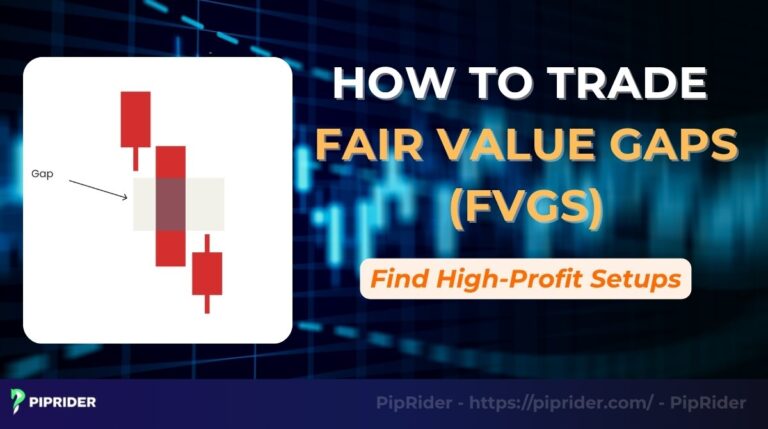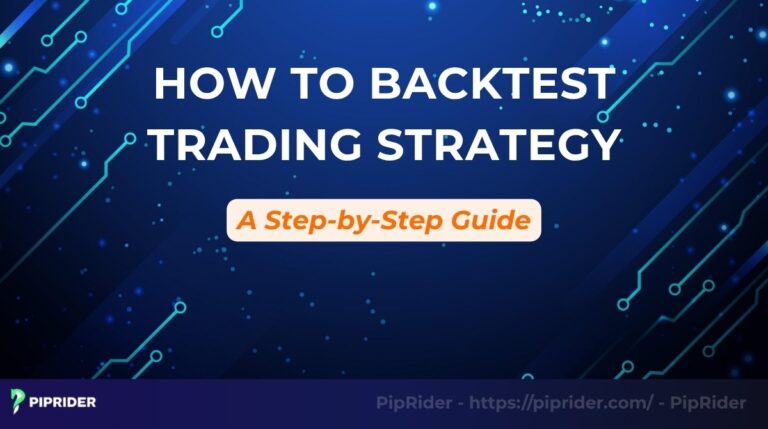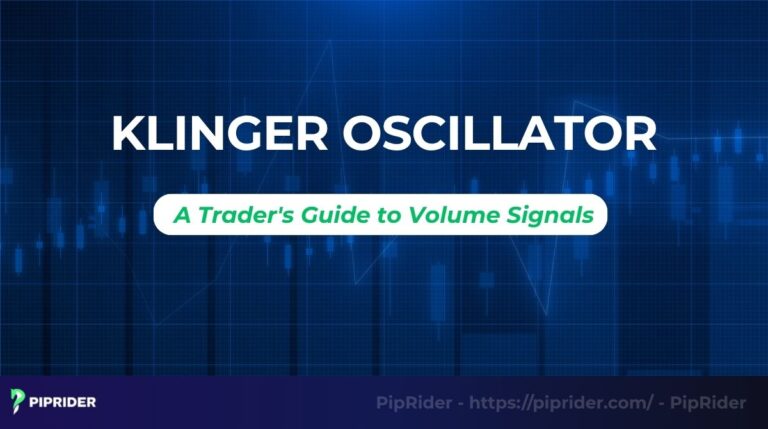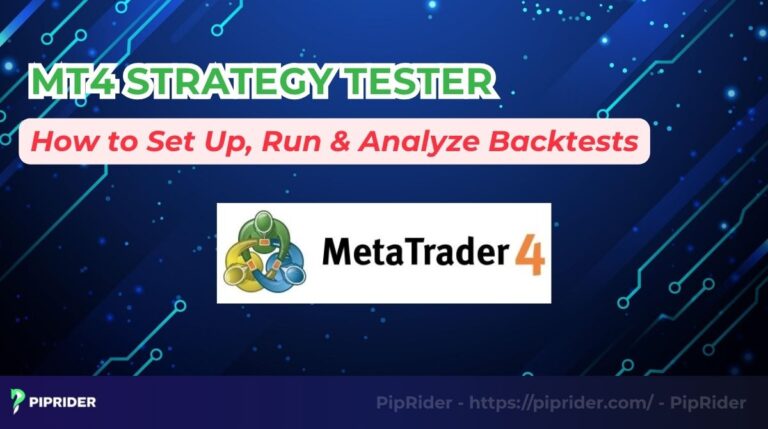Price tells you what happened, but trading activity reveals how much effort it took. Developed by Richard W. Arms Jr., the Ease of Movement Indicator (EOM) combines price volatility and trading volume to ask a crucial question: How easily did the price move? This unique focus on market efficiency helps traders pinpoint when “smart money” is quietly shifting the price with minimal resistance.
This guide provides an expert, step-by-step analysis of the EOM. It equips you with the practical strategies needed to accurately confirm market drive and gain a statistical edge in your technical analysis.
Key Takeaways
- Ease of Movement is a momentum oscillator measuring the efficiency of price variation and how much volume was required for a given price move.
- Oscillates around zero. Positive values signal price is rising easily (bullish efficiency); negative values signal price is falling easily (bearish efficiency).
- The Zero-Line Crossover confirms the direction of the momentum shift (buy/sell signal).
- EOM is sensitive. It must be paired with a Moving Average (MA) for smoothing and context or other indicators like RSI to validate signal strength.
- It compares the current price range movement to the Volume-to-Range Ratio (Box Ratio).
1. What Is the Ease of Movement Indicator?
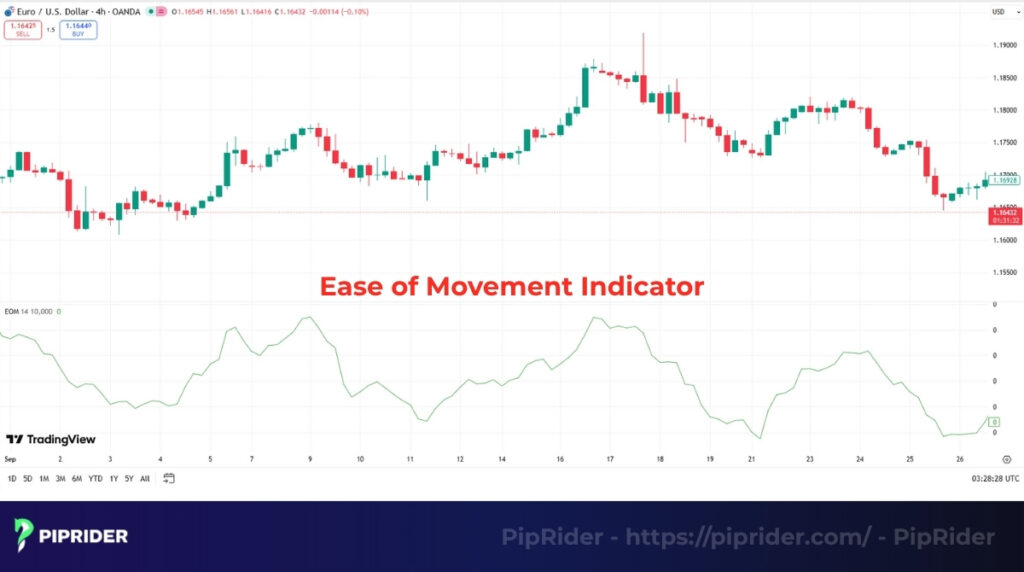
The Ease of Movement (EOM), often referred to as EMV (Ease of Movement Value), is a unique technical momentum oscillator developed by Richard W. Arms Jr. (also the creator of the Arms Index, or TRIN) (Trading Technologies, n.d.)
The primary goal of the Ease of Movement indicator is to quantify the relationship between price change (volatility) and trading volume to measure the market’s efficiency.
- High EOM suggests the price is moving significantly with low volume.
- Low EOM means a large amount of volume is needed for a small price change (high friction).
The underlying theory is simple: if the price moves easily, it is likely to continue that movement.
The EOM stands apart from standard volume oscillators like On-Balance Volume (OBV) or the Chaikin Money Flow (CMF) because of its combined approach:
| Indicator | Primary Focus | EOM’s Key Difference |
| OBV | Measures cumulative volume flow. | OBV only focuses on which direction volume flowed (up or down day). EOM factors in the size of the price move relative to the volume. |
| CMF | Measures the degree of buying/selling pressure over a period. | CMF compares the closing price to the high-low range. EOM directly incorporates the magnitude of the price shift and divides it by volume, directly measuring efficiency. |
In short, Ease of Movement is less concerned with the absolute amount of volume and more concerned with the result (price movement) per unit of effort (volume).
2. Understanding How the Ease of Movement Works
The Ease of Movement indicator reflects the effort required to change a security’s price. It combines the distance the price moves with the volume traded during that period.
2.1. Efficiency and the Zero Line
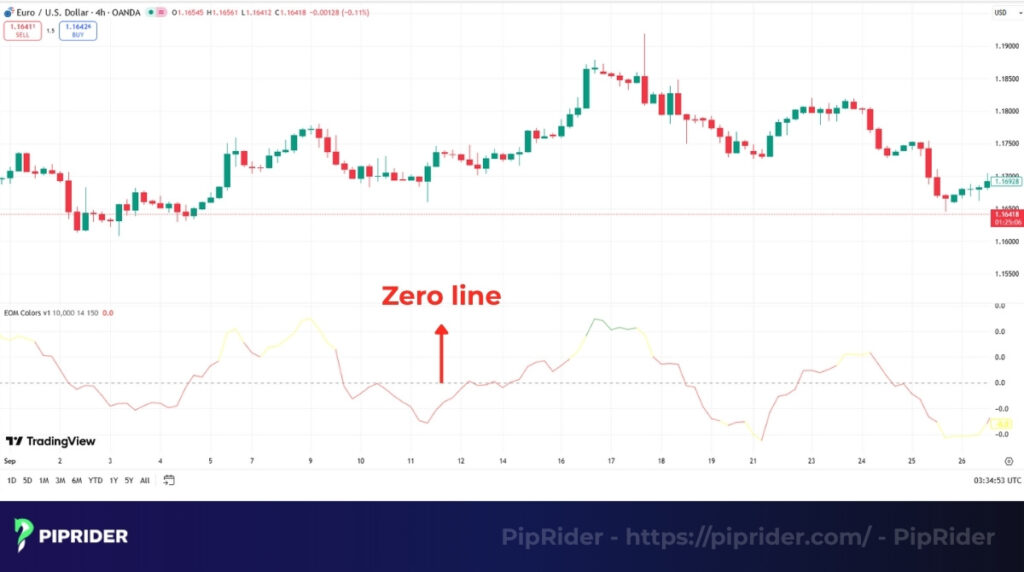
- Reflecting “Ease”: EOM is high (positive) when the price moves significantly with low volume, indicating little resistance (high efficiency). It is low (negative) when the price moves significantly with low volume in the opposite direction.
- The center of balance: EOM oscillates around the Zero Line. This line represents the point of equilibrium between supply and demand. Readings very close to zero indicate the market is lacking momentum, with either minimal or high volume causing little price movement (high friction).
2.2. Interpreting Momentum Control
The sign of the EOM value dictates which side is currently in control:
- Positive EOM: Occurs when the price moves up easily. This signals that buyers (demand) are in control and are pushing the price higher with little resistance from sellers.
- Negative EOM: Occurs when the price moves down easily. This signals that sellers (supply) are dominating and are driving the price lower with little resistance from buyers.
3. How to Calculate the Ease of Movement Indicator
The EOM calculation measures price movement efficiency. It compares the distance the price traveled to the volume used to move it.
3.1. The Formula
The 1-period EOM is calculated by dividing the distance the price’s midpoint moved by the Volume-to-Range Ratio (the friction):
EOM = [(High+Low) / 2 − (Previous High + Previous Low) /2 ] / (Volume / (High − Low))
EOM = Distance Moved / Friction
- Numerator (Distance Moved): Measures how far the typical price (midpoint) has moved from the previous period. This captures volatility.
- Denominator (Friction): Measures the Volume-to-Range Ratio. High volume needed for a small price move results in a high denominator, indicating high friction and low EOM. This ratio is also known as the Box Ratio.
3.2. Simplified Calculation Example
Let’s assume the average price moved up by $0.50 from yesterday, and the Volume-to-Range Ratio (Friction) for that move was 2,000.
EOM = Distance Moved / Friction Ratio = $0.50 / 2,000 = 0.00025
A positive EOM confirms the price moved up easily with low resistance.
3.3. Smoothed EOM (The Standard Setting)
The raw 1-period EOM is too erratic for reliable trading. Therefore, the EOM seen on the price chart is always a smoothed EOM, created by applying the MA to the raw values.
- The most common setting is a 14-period Simple or Exponential Moving Average (SMA/EMA) of the raw EOM.
- This smoothing process eliminates noise and generates clearer, more actionable signals, allowing traders to focus on genuine momentum shifts.
4. How to Interpret the Ease of Movement Indicator
Interpreting the EOM focuses on the indicator’s position relative to the zero line, which acts as the center of equilibrium. This process is a core element of technical analysis.
| EOM Value | Meaning | Price Action & Momentum |
| Positive Value (Above 0) | Price is moving up easily (low friction). | Bullish Control: Strong buying pressure is dominating with minimal effort. |
| Negative Value (Below 0) | Price is moving down easily (low friction). | Bearish Control: Strong selling pressure is dominating with minimal effort. |
| Near Zero | Movement is difficult (high friction). | Indecision/Consolidation: The market lacks directional bias; high volume causes little price change, or volume is too low for movement. |
The Zero-Line Crossover
The most significant signal is the crossover of the zero line, which confirms a fundamental shift in momentum control, generating reliable trading signals:
- Cross above 0: Signals a change in momentum from neutral/downward to upward. This is often used as a buy signal.
- Cross below 0: Signals a change in momentum from neutral/upward to downward. This is often used as a sell signal.
5. Using Ease of Movement in Trading
The Ease of Movement indicator provides several high-probability trading strategies by validating momentum and trend integrity.
5.1. Zero-Line Crossover Strategy
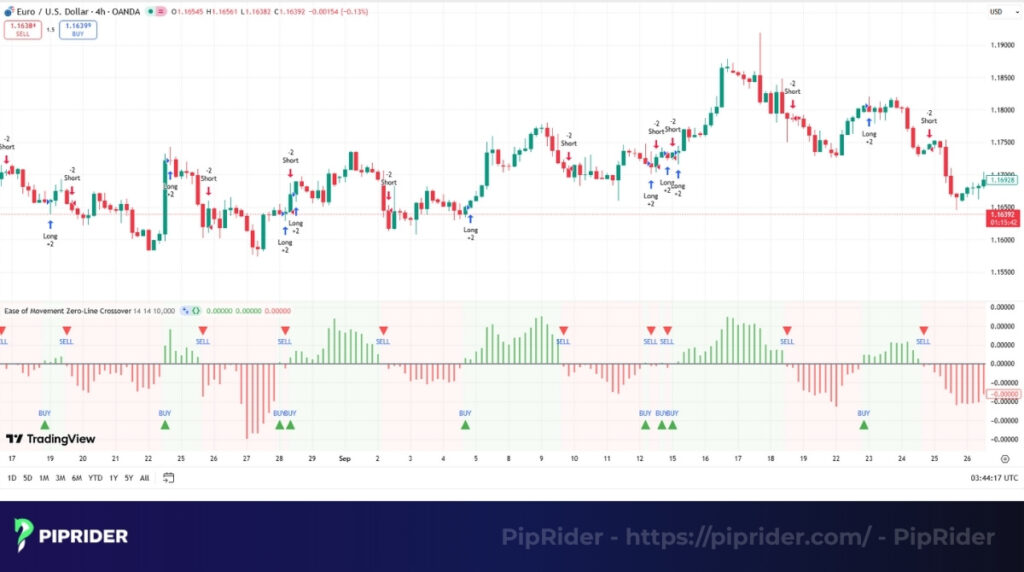
This is the primary way to generate entry signals, based on the shift in market control.
- Buy signal (long entry): Execute a buy when the smoothed EOM crosses up above the Zero Line (0). This confirms that the market has easily shifted into positive trend strength, indicating strong buying efficiency.
- Sell signal (short entry): Execute a sell when the smoothed EOM crosses down below the Zero Line (0). This confirms that the market has shifted into negative momentum, indicating strong selling efficiency.
5.2. Trend Confirmation Strategy

The Ease of Movement should be used as a filter to validate the strength and quality of a price trend.
- Trend confirmation: Combine EOM with MA, such as the 50-period EMA. During an uptrend (price above MA), look for positive EOM readings to confirm that the upward movement is supported by high efficiency.
- Breakout filter: Use EOM to validate key breakouts. A true, sustainable breakout occurs when the price breaks a resistance level and the EOM simultaneously surges to a new positive extreme, confirming low resistance for the move.
5.3. Divergence Setup

Divergence between the EOM and price behavior is a powerful early warning signal for potential reversals.
- Bullish: Price makes a lower low, but the EOM makes a higher low. This suggests selling is weakening, signaling an early reversal warning to the upside, a potential bullish reversal.
- Bearish: Price makes a higher high, but the EOM makes a lower high. This suggests buying is weakening, signaling an early reversal warning to the downside.
6. Confirming Other Signals with EOM
The EOM indicator’s focus on efficiency makes it a powerful filter when combined with other indicators, validating signal quality and context.
- EOM + RSI (Validating Extremes): Use EOM to confirm the strength of overbought/oversold conditions signaled by the Relative Strength Index (RSI). If the RSI is oversold, but the EOM is strongly negative, it confirms that the downward move was highly efficient and should be respected.
- EOM + MACD (Trend Momentum): Use EOM to confirm the underlying volume efficiency during a strong trend indicated by the Moving Average Convergence Divergence (MACD). If the MACD is bullish and the EOM is strongly positive, it validates that the uptrend has minimal friction.
- EOM + Bollinger Bands (Breakout Filter): EOM helps distinguish between true and false breakouts. A sustainable price move outside the Bollinger Bands is confirmed when the EOM simultaneously surges in the direction of the breakout, indicating low resistance.
Optimal Market Conditions
The Ease of Movement works most effectively in markets with stable volume and moderate volatility. It performs poorly when volume is highly erratic or during “gap-up/gap-down” events where the calculation can be skewed.
7. Ease of Movement Indicator Example
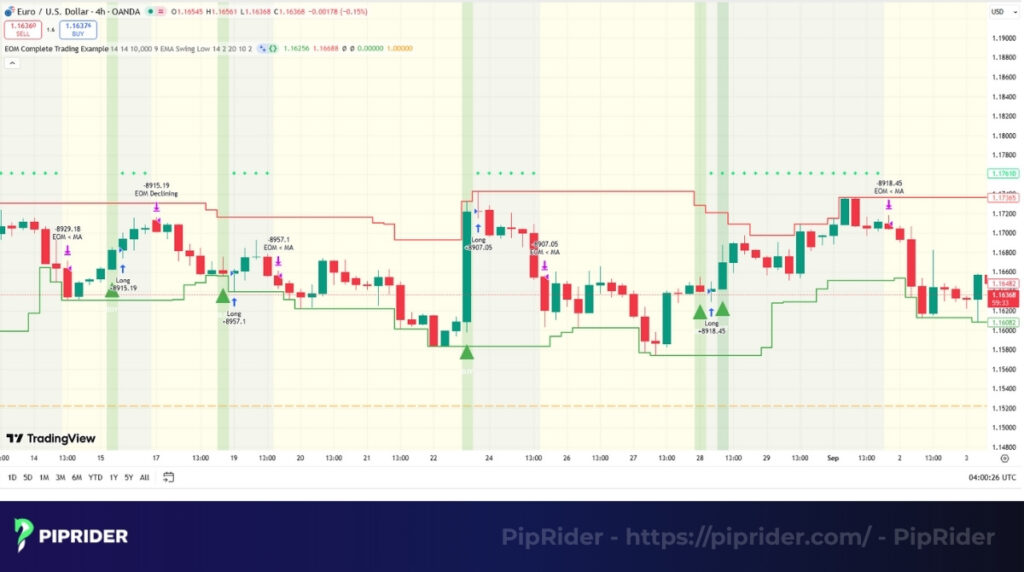
To use the EOM effectively, focus on the zero-line crossover after a period of consolidation, which signals a low-resistance entry.
Imagine an asset is trading sideways near a key support level, and the EOM is flatlining near zero.
- Buy Entry: Enter long on the bar after the smoothed EOM crosses up above the zero line (0). This confirms a shift to bullish momentum with minimal volume friction.
- Stop-Loss: Place the stop-loss below the lowest low recorded during the bar where the EOM crossover occurred (or the previous swing low) to protect capital.
- Take-Profit: Set the target near the next major resistance level where the EOM begins to decline sharply, or when the EOM crosses back below its own Moving Average (e.g., a 9-period EMA of the EOM).
The EOM works best on timeframes that provide stable volume data and sufficient price movement:
The Daily Chart (D) is ideal for swing trading, as it filters out most intraday noise. The 4-Hour Chart (4H) is good for medium-term day trading and capturing significant momentum shifts within a week. Avoid very low timeframes (M5, M15) where the noise and erratic volume skew the EOM calculation.
8. Special Considerations
While powerful, the Ease of Movement has specific limitations that traders must recognize to avoid false signals.
- Forex incompatibility: The EOM is generally not suitable for the Forex market. Since Forex is an Over-The-Counter (OTC) market, there is no standardized central volume data. It is provided by individual brokers and is incomplete, which significantly compromises the accuracy of the EOM calculation.
- Skewed signals in extremes: The indicator can produce highly skewed or misleading signals during periods of extremely low volume or very sharp price spikes. In these situations, the volume-to-range ratio (friction) becomes distorted, making the EOM value unreliable.
- Confirmation is mandatory: Due to its sensitivity and potential for noise, the Ease of Movement should never be used as a standalone indicator. It must always be combined with a trend-following tool (MA) and a volatility or momentum indicator (RSI/MACD) to filter out noise and validate the strength of any signal.
9. Frequently asked questions about Ease of Movement Indicator
10. Conclusion
The Ease of Movement indicator is a sophisticated tool that moves beyond simple volume counting. Its primary role is measuring market efficiency, or the “effort versus result” of price movement. It helps smart traders see the true market drive by identifying low-friction moves.
Because the EOM is sensitive, it should always be used as a confirmation filter. For highly reliable signals, combine EOM with RSI or MACD to filter false entries and ensure the move is backed by both volume efficiency and general momentum strength. EOM is not just a volume indicator; it’s a smart money flow indicator that reveals the market’s path of least resistance on the price chart.
To further refine your trading toolkit and discover more powerful indicators like EOM, be sure to follow Piprider and check our detailed Broker Reviews section.


